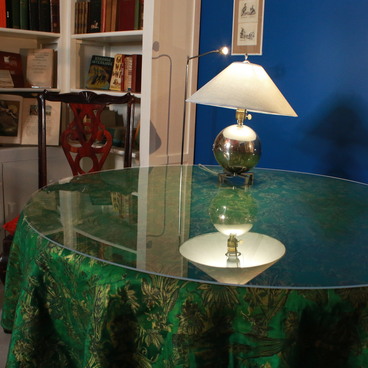In the second half of the 1930s, Sergei Eisenstein became interested in the philosophical teachings and religions of the Far East and India. He was especially fascinated by classic Buddhism with its rich sacred imagery. In the director’s apartment, on Potylikha Street, where he lived from 1935 to 1948, there was an image of Goddess SitatapAtra AparajIta on the bedroom wall to the right of the door to the library.
This Buddhist tangka supposedly comes from Mongolia or BuryAtia. The mandala in the center, garlanded by flames, features the one thousand-faced and one thousand-armed Goddess Sitatapatra Aparajita, also known as Ushnisha Sitatapatra Aparajita, the All-Seeing Liberator of the White Parasol. According to the legend, she emerged from Buddha ShakyamUni’s ushnIsha when he realized the need to protect all beings from evil forces and malevolent influences. The ushnIsha is a three-dimensional oval at the top of Buddha’s head, which symbolizes the attainment of enlightenment.
The Goddess’s two arms are pressed to her chest. In her right hand, she is holding a staff with a ball-like gold tip: dharmachakra. This is a Buddhist symbol of dharmas and Buddha’s teaching about the path to enlightenment and liberation from the karmic cycle of reincarnations in samsara. In her remaining hands, the Goddess is holding arrows and other weapons, while above her is a white umbrella decorated with ribbons. The deity’s umbrella is intended to ward off and dispel the burning rays of all woes and dangers. There are a lot of tiny human figures at Sitatapatra Aparajita’s feet. At the bottom, under the pedestal, there are three small ovals of fire with blue faced deities or demons; in their left hands, they are holding gold-tipped staffs; there are human faces peeking out of the folds of their garments, each deity trampling a naked human body. Above the mandala, on the colored clouds, there are fair-faced deities.
The goddess’s 500 right hands and feet bless all beings, while the left ones protect them driving away all things harmful. Her thousand heads are painted in the five colors of wisdom, each wearing a different facial expression: the blue ones are ireful and awe-inspiring; the whites are attractive, stern, and satisfied; the yellows are terrifying, wild, and playful; the reds are tough, magnificent, and formidable, while the green ones are compassionate and peaceful. The colors symbolize the deity’s power over all corners of the world, including the center. It is a white form of light in a state of Supreme Joy.
This Buddhist tangka supposedly comes from Mongolia or BuryAtia. The mandala in the center, garlanded by flames, features the one thousand-faced and one thousand-armed Goddess Sitatapatra Aparajita, also known as Ushnisha Sitatapatra Aparajita, the All-Seeing Liberator of the White Parasol. According to the legend, she emerged from Buddha ShakyamUni’s ushnIsha when he realized the need to protect all beings from evil forces and malevolent influences. The ushnIsha is a three-dimensional oval at the top of Buddha’s head, which symbolizes the attainment of enlightenment.
The Goddess’s two arms are pressed to her chest. In her right hand, she is holding a staff with a ball-like gold tip: dharmachakra. This is a Buddhist symbol of dharmas and Buddha’s teaching about the path to enlightenment and liberation from the karmic cycle of reincarnations in samsara. In her remaining hands, the Goddess is holding arrows and other weapons, while above her is a white umbrella decorated with ribbons. The deity’s umbrella is intended to ward off and dispel the burning rays of all woes and dangers. There are a lot of tiny human figures at Sitatapatra Aparajita’s feet. At the bottom, under the pedestal, there are three small ovals of fire with blue faced deities or demons; in their left hands, they are holding gold-tipped staffs; there are human faces peeking out of the folds of their garments, each deity trampling a naked human body. Above the mandala, on the colored clouds, there are fair-faced deities.
The goddess’s 500 right hands and feet bless all beings, while the left ones protect them driving away all things harmful. Her thousand heads are painted in the five colors of wisdom, each wearing a different facial expression: the blue ones are ireful and awe-inspiring; the whites are attractive, stern, and satisfied; the yellows are terrifying, wild, and playful; the reds are tough, magnificent, and formidable, while the green ones are compassionate and peaceful. The colors symbolize the deity’s power over all corners of the world, including the center. It is a white form of light in a state of Supreme Joy.



